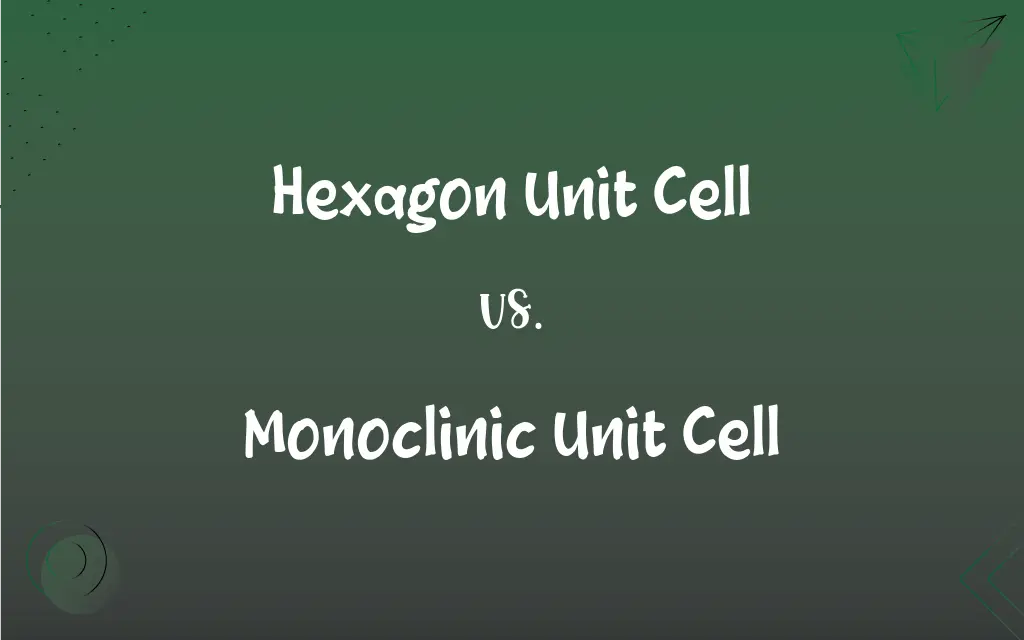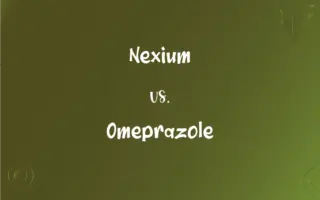Hexagon Unit Cell vs. Monoclinic Unit Cell: What's the Difference?
Edited by Aimie Carlson || By Janet White || Published on September 8, 2024
Hexagon unit cell has angles of 120° between sides and equal a and b axes, while monoclinic unit cell has unequal axes with one angle not 90°.

Key Differences
A hexagon unit cell is characterized by its six-sided symmetry, where each internal angle is 120 degrees, providing a distinct geometric shape that is prevalent in various crystalline structures. This cell structure is pivotal in the arrangement of atoms within a crystal lattice, showcasing a uniformity and symmetry that is essential for the formation of certain types of crystals. In contrast, a monoclinic unit cell exhibits a less symmetrical structure, with three axes of unequal lengths and two angles at 90 degrees, while the third angle is different. This unique arrangement leads to a diverse range of crystal forms and is indicative of the complex interplay between atomic forces within the crystal lattice.
The geometry of a hexagon unit cell contributes significantly to the physical properties of materials, including their strength, conductivity, and optical properties. The uniform distribution of atoms within the hexagonal structure facilitates the efficient transmission of light and electricity, making it ideal for applications in electronics and photonics. On the other hand, the monoclinic unit cell, with its asymmetric angles and varied axis lengths, can lead to materials with anisotropic properties. This means that their physical characteristics can vary depending on the direction of measurement, which is useful in applications requiring directional properties, such as piezoelectric materials.
When examining the stability and reactivity of crystalline materials, the hexagon unit cell is often associated with materials that exhibit high stability and low reactivity due to the strong bonding and symmetry within the lattice. This makes it suitable for use in high-strength materials and applications requiring long-term stability. The monoclinic unit cell, however, can accommodate a wider range of bonding angles and distances, allowing for the formation of materials with unique chemical properties. This versatility is crucial for the development of catalysts and materials with specific reactivity patterns.
In terms of crystal growth and development, the hexagon unit cell promotes uniform and predictable growth patterns, which are essential for the production of large, defect-free crystals. This is particularly important in the semiconductor industry, where the quality of the crystal directly affects the performance of the device. Conversely, the monoclinic unit cell's flexibility in terms of bond angles and distances allows for the growth of crystals with complex structures, which are often sought after in the pharmaceutical industry for their unique interaction with biological molecules.
The study of crystallography and material science greatly benefits from the understanding of hexagon unit cell and monoclinic unit cell structures. The hexagonal structure is fundamental in the research of new materials with specific optical and electrical properties, while the monoclinic structure offers insights into the creation of materials with bespoke chemical and physical characteristics. Both unit cells play a crucial role in the advancement of technology and the development of new materials, highlighting the importance of crystal structure in the design and application of materials.
ADVERTISEMENT
Comparison Chart
Axis Lengths
Equal a and b axes, c axis different
Unequal axes, a ≠ b ≠ c
Internal Angles
Angles between sides are 120°
Two angles are 90°, one angle ≠ 90°
Symmetry
High symmetry with six-fold rotational symmetry
Lower symmetry due to one non-90° angle
Crystal System
Part of the hexagonal crystal system
Part of the monoclinic crystal system
Application in Materials
Ideal for materials requiring uniform properties
Suitable for materials with directional properties
ADVERTISEMENT
Hexagon Unit Cell and Monoclinic Unit Cell Definitions
Hexagon Unit Cell
Integral to materials with high thermal and electrical conductivity.
Copper's hexagon unit cell facilitates its efficient electrical conductivity.
Monoclinic Unit Cell
It characterizes crystals with lower symmetry and directional properties.
The unique piezoelectric effect in some materials is due to their monoclinic unit cell.
Hexagon Unit Cell
A hexagon unit cell is a six-sided, symmetric crystal structure.
Graphene's strength and conductivity are due to its hexagon unit cell arrangement.
Monoclinic Unit Cell
Common in materials that exhibit anisotropic physical behaviors.
The monoclinic unit cell in orthoclase feldspar results in different properties along its axes.
Hexagon Unit Cell
Characterized by equal lengths and 120° angles between its sides.
The hexagon unit cell in honeycomb structures contributes to their remarkable stability.
Monoclinic Unit Cell
Allows for a diverse range of crystalline forms and material characteristics.
Monoclinic unit cell structures in clays contribute to their varied plasticity and reactivity.
Hexagon Unit Cell
It forms the foundational geometry for certain crystalline solids.
Ice crystals exhibit a hexagon unit cell pattern, explaining their unique shapes.
Monoclinic Unit Cell
A monoclinic unit cell has three unequal axes with one angle not at 90°.
Gypsum crystals are formed in a monoclinic unit cell structure, affecting their physical properties.
Hexagon Unit Cell
Found in materials that exhibit strong covalent bonding.
Silicon carbide's durability is a result of its hexagon unit cell configuration.
Monoclinic Unit Cell
Suited for complex chemical compounds and pharmaceuticals.
Many drug molecules crystallize in the monoclinic unit cell for targeted interaction with biological systems.
FAQs
What is unique about the monoclinic unit cell structure?
The monoclinic unit cell has three axes of unequal length, with two axes forming right angles and the third forming an angle different from 90 degrees.
How do hexagon unit cells affect material properties?
Materials with hexagon unit cells often exhibit high strength, stability, and uniform physical properties due to their symmetric structure.
Can the hexagon unit cell be found in nature?
Yes, hexagon unit cells are prevalent in nature, evident in structures like honeycombs and ice crystals, due to their efficient packing and stability.
What materials typically have a monoclinic unit cell?
Materials with monoclinic unit cells include certain minerals, crystals, and complex chemical compounds, offering diverse physical and chemical behaviors.
What role do hexagon unit cells play in technology?
Hexagon unit cells are crucial in the development of electronic and photonic devices due to their conducive properties for light and electricity transmission.
Why are monoclinic unit cells important in material science?
Monoclinic unit cells allow for the creation of materials with unique chemical and physical properties, including anisotropy and tailored reactivity.
What defines a hexagon unit cell?
A hexagon unit cell is characterized by six sides of equal length and internal angles of 120 degrees, common in materials with high symmetry.
What is the significance of axis lengths in monoclinic unit cells?
The unequal axis lengths in monoclinic unit cells contribute to the material's anisotropic properties, affecting how it behaves in different directions.
How does the hexagon unit cell contribute to crystal growth?
The symmetry of the hexagon unit cell promotes uniform crystal growth, essential for creating large, defect-free crystals for industrial applications.
How does the monoclinic unit cell affect material reactivity?
The unique angles and bond lengths in monoclinic unit cells can enhance material reactivity, making them ideal for catalytic and pharmaceutical uses.
What industries benefit from hexagon unit cell materials?
Industries such as electronics, aerospace, and renewable energy benefit from the properties of materials with hexagon unit cells.
Is it possible to transform a monoclinic unit cell into another structure?
Yes, under certain conditions, a monoclinic unit cell can transform into another structure through physical or chemical processes, affecting its properties.
How do monoclinic unit cells contribute to material diversity?
Monoclinic unit cells contribute to material diversity by allowing for a wide range of physical and chemical properties due to their structural flexibility.
How does symmetry differ between hexagon and monoclinic unit cells?
Hexagon unit cells display high symmetry with equal sides and angles, while monoclinic unit cells have lower symmetry due to their unequal axes and angles.
Are monoclinic unit cells versatile in applications?
Yes, the versatility of monoclinic unit cells makes them suitable for a wide range of applications, from catalysts to pharmaceuticals.
What challenges arise with monoclinic unit cell materials?
Monoclinic unit cell materials can present challenges in consistency and predictability due to their complex structures and anisotropic behaviors.
Can hexagon unit cells be engineered in synthetic materials?
Yes, synthetic materials can be engineered to have hexagon unit cells to exploit their desirable physical properties for specific applications.
What research opportunities do hexagon unit cells offer?
Hexagon unit cells offer research opportunities in developing new materials with enhanced electrical, thermal, and mechanical properties.
Can monoclinic unit cell materials be customized for specific applications?
Yes, the flexibility of monoclinic unit cells allows for the customization of materials for specific applications, including targeted drug delivery and sensors.
What computational methods are used to study hexagon unit cells?
Computational methods such as density functional theory and molecular dynamics simulations are used to study the properties of hexagon unit cells.
About Author
Written by
Janet WhiteJanet White has been an esteemed writer and blogger for Difference Wiki. Holding a Master's degree in Science and Medical Journalism from the prestigious Boston University, she has consistently demonstrated her expertise and passion for her field. When she's not immersed in her work, Janet relishes her time exercising, delving into a good book, and cherishing moments with friends and family.
Edited by
Aimie CarlsonAimie Carlson, holding a master's degree in English literature, is a fervent English language enthusiast. She lends her writing talents to Difference Wiki, a prominent website that specializes in comparisons, offering readers insightful analyses that both captivate and inform.






































































